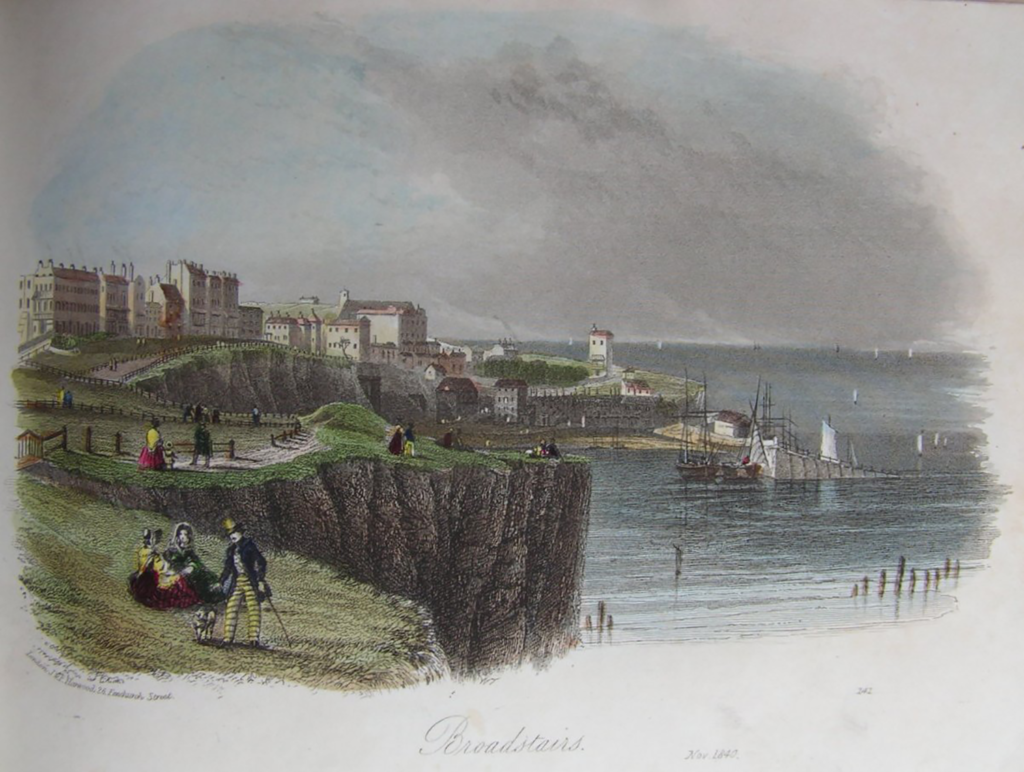The original building which stood here
In mid-C19th etchings of the bay, the building has windows across its upper half and tall doors at the beach end. When it starts to appear in postcards, c.1890-1910, it can be seen in more detail with windows on three storeys, the top two storeys clapboarded like the Boathouse still standing on Broadstairs’ jetty.
In 1910 it was bought by Sir Francis Laking (physician to King Edward VII), at the same time as he bought York Gate House next door; it was described in the deeds as a ‘Boat Store’ and as this area of town was in the C18th the site of White’s Shipbuilders, it’s likely that this was its original purpose.


York Gate Hall (1912 – 1965)
In 1912 the formerly scruffy working building was reborn as ‘York Gate Hall’. It had been re-modelled in neo-classical style by Sir Francis’ son, historian Sir Guy Laking: the interior was now one large space with a balcony, the exterior clad in brick and flint with oeil de boeuf windows in the pediments, a Palladian window at the beach end (matching York Gate House) and ‘dentil’ plasterwork detail around the cornicing inside and out.
The new Hall housed Sir Guy’s armour collection. When he died in 1919, the building was sold to Broadstairs and St Peter’s Urban District Council which used it to store beach equipment and hired it out in the season for entertainment, 16mm cartoon shows and puppet shows. One regular hire was the Laurey Puppet Theatre, whose Joy Laurey created the ‘Mr Turnip’ puppet character for one of the first British TV shows for children, Whirligig.
In the early/mid 1960s, after Broadstairs’ two purpose-built cinemas the Odeon and the Picture House had both closed, the Hall operated briefly as ‘York Gate Cinema’.
The Windsor (1965 – 2006)
York Gate Hall was permanently converted into a cinema by R H Field of Winfield Cinemas, who had also owned the Carlton and Regal in nearby Westgate and Birchington. The ‘Windsor’ had an enclosed projection box with 35mm projector, a new doorway cut into the frontage on Harbour Street, and a foyer leading to a blacked-out auditorium with curtained screen, 29 seats on the balcony and 126 seats in the stalls below. The internal layout has remained largely unchanged ever since. In 1974 the building was Grade II listed by Historic England.
The Windsor changed hands in 1986, was renovated, and became the home once a week of Thanet Film Society (est.1995), part of the British Federation of Film Societies / Cinema for All, which expanded the cinema’s mainstream film programme to offer a weekly ‘art house’ film.

The Palace (2006 – present)
Starting in 2006, the cinema’s third owners transformed the, by then, slightly shabby Windsor into the ‘Palace’. The name change ushered in the cinema’s conversion to digital, with a 2K projector and Dolby Digital 5.1 surround sound. They also installed a screen almost the width of the building, enlarged the foyer for more concessions space, reduced the total seating capacity to 111, refurbished throughout and brought in an illuminated cinema organ. In 2008 they were interviewed for an article in The Guardian featuring ‘10 of the best’ independent small cinemas in the UK.
In 2016 the Palace was taken on by its fourth and current owners. As well as changes including air conditioning and online ticketing, they have moved the cinema a step away from superheroes and blockbusters, tagging the Palace as a place ‘for people who love independent film’.
The programme is a mix of new and classic independent film from around the world, plus Q&As, live performance, ‘Palace Sunday Silents’ with piano accompaniment by composer/performer Lillian Henley and youth-curated events. The cinema has welcomed local education groups and partners including Ramsgate Int’l Film & TV Festival, Margate Film Festival, POW Thanet, Festival of Cats and Turner Contemporary, and worked with national and regional organisations including Heritage Open Days, Into Film and BFI Film Hub South East.
The Palace has been a film location twice in recent years, featuring as a village hall visited by Maggie Smith in The Lady in the Van (2015) and as itself in an early scene featuring Rose Byrne and Chris O’Dowd in Juliet, Naked (2018).
Have a memory from the Windsor/Palace’s history you’d like to share? We’d love to hear it. Please email us here and we’ll get back to you. Thank you!